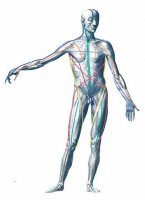CoolTweetPete
Member
I use the term missing link loosely as Ray has addressed "tensegrity" in the past. This is a term Buckminster Fuller coined in relation to architecture, but this model is being related to the structure of our bodies in new science on the "Anatomy Trains". These can be defined as myofascial continuities that allow for most movement as we know it. The old model of muscles initiating motion appears to be incorrect. The Extracellular Matrix seems to communicate much faster than the nervous system, using vibration to do so.
The book Anatomy Trains by Thomas Myers outlines the new science and gives us a fresh look at structural integrity. Myers outlines a fascinating topic he calls "Microtensegrity" in the book and I think this may be a missing link for people, who are trying to regain their health.
I will quote him here for effect,
"It appears that cells assemble and stabilize themselves via tensional signaling, that they communicate with and move through the local surroundings via adhesive molecules and that the musculo-fascial-skeletal system as a whole functions largely as a tensegrity.. Structural intervention works through this system as a whole changing the mechanical relations among countless number of individual tensegrity-linked parts and linking our perception of our kinesthetic self to the dynamic interaction between cells and matrix" (Anatomy Trains, Myers, P. 58)
Basically he is saying that cells needs to communicate via these fascial lines and when posture has been compromised from a lifetime of sitting, the cells are less able to communicate. I think this is analogous to the laying down of degenerative collagen fibers Dr. Peat has discussed.
To make things even more profound, Dr. Myers described an additional microtensegrity effect he and his colleagues observed in experimentation,
"To investigate the possibility further, we developed a method to engineer cells shapes and function. They forced living cells to take on different shapes -- spherical or flattened, round or square by placing them on tiny adhesive 'islands' composed of extra-cellular matrix. Each adhesive island was surrounded by a Teflon-like surface to which cells could not adhere"
The results were mindblowing to me when I read them,
"By simply modifying the shape of the cell, they could switch cells among different genetic programs. Cells that were stretched and spread flat became more likely to divide, whereas rounded cells that were prevented from spreading activated a suicidal apoptic gene. When cells are neither too expanded or hemmed in, they spend their energy neither in dividing nor in dying. Instead, they differentiated themselves in a tissue-specific manner.. Thus mechanical information apparently combines with chemical signals to tell the cell and the cytoskeleton what to do." (Myers)
This makes me consider the plight of the desk job worker, who spends 8 hours a day at a chair. The superficial front line (shown below) is destined to suffer in such a situation. The seated posture will warp these lines as they relate to one another as the years pile on and postural instabilities will become unavoidable in old age.

I think this may be a missing link for some people. I self diagnosed with a condition Myers outlines in a chapter about the superficial back line a few months ago. He talks about how shortness in the front line results in the back line "creeping upward". I can say with a great deal of certainty that I had had this condition for going on 15 years without being aware.
Our bodies just adapt to their new position be it optimal or not. I had developed severe scar tissue around my cervical spine, which a masseuse made me aware of in 2015. Since working on these problems and getting some results, I have seen dramatic improvements in my health.
As many of you know I have had what feels like an infinite struggle trying to regain lost scalp hair. I think this truly was the missing link for initiating a profound change. I chuckled to myself the other day when my barber noticed that my hair growth pattern is changing. I attribute it to the fascial work I've done (soft tissue work and stretching).
I think this may be a great option for someone who thinks they may have a compromised fascial system. It's very enriching and satisfying to regain something I did not know I had lost.
Photos of the other meridians,
Superficial Back Line,

Lateral line,

The Spiral Line,

The Arm Lines,

The Functional Lines,

The Deep Front Line,

The book Anatomy Trains by Thomas Myers outlines the new science and gives us a fresh look at structural integrity. Myers outlines a fascinating topic he calls "Microtensegrity" in the book and I think this may be a missing link for people, who are trying to regain their health.
I will quote him here for effect,
"It appears that cells assemble and stabilize themselves via tensional signaling, that they communicate with and move through the local surroundings via adhesive molecules and that the musculo-fascial-skeletal system as a whole functions largely as a tensegrity.. Structural intervention works through this system as a whole changing the mechanical relations among countless number of individual tensegrity-linked parts and linking our perception of our kinesthetic self to the dynamic interaction between cells and matrix" (Anatomy Trains, Myers, P. 58)
Basically he is saying that cells needs to communicate via these fascial lines and when posture has been compromised from a lifetime of sitting, the cells are less able to communicate. I think this is analogous to the laying down of degenerative collagen fibers Dr. Peat has discussed.
To make things even more profound, Dr. Myers described an additional microtensegrity effect he and his colleagues observed in experimentation,
"To investigate the possibility further, we developed a method to engineer cells shapes and function. They forced living cells to take on different shapes -- spherical or flattened, round or square by placing them on tiny adhesive 'islands' composed of extra-cellular matrix. Each adhesive island was surrounded by a Teflon-like surface to which cells could not adhere"
The results were mindblowing to me when I read them,
"By simply modifying the shape of the cell, they could switch cells among different genetic programs. Cells that were stretched and spread flat became more likely to divide, whereas rounded cells that were prevented from spreading activated a suicidal apoptic gene. When cells are neither too expanded or hemmed in, they spend their energy neither in dividing nor in dying. Instead, they differentiated themselves in a tissue-specific manner.. Thus mechanical information apparently combines with chemical signals to tell the cell and the cytoskeleton what to do." (Myers)
This makes me consider the plight of the desk job worker, who spends 8 hours a day at a chair. The superficial front line (shown below) is destined to suffer in such a situation. The seated posture will warp these lines as they relate to one another as the years pile on and postural instabilities will become unavoidable in old age.

I think this may be a missing link for some people. I self diagnosed with a condition Myers outlines in a chapter about the superficial back line a few months ago. He talks about how shortness in the front line results in the back line "creeping upward". I can say with a great deal of certainty that I had had this condition for going on 15 years without being aware.
Our bodies just adapt to their new position be it optimal or not. I had developed severe scar tissue around my cervical spine, which a masseuse made me aware of in 2015. Since working on these problems and getting some results, I have seen dramatic improvements in my health.
As many of you know I have had what feels like an infinite struggle trying to regain lost scalp hair. I think this truly was the missing link for initiating a profound change. I chuckled to myself the other day when my barber noticed that my hair growth pattern is changing. I attribute it to the fascial work I've done (soft tissue work and stretching).
I think this may be a great option for someone who thinks they may have a compromised fascial system. It's very enriching and satisfying to regain something I did not know I had lost.
Photos of the other meridians,
Superficial Back Line,

Lateral line,

The Spiral Line,

The Arm Lines,

The Functional Lines,

The Deep Front Line,





